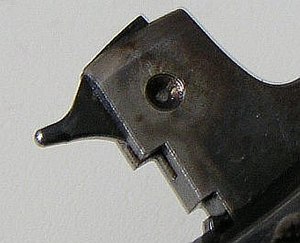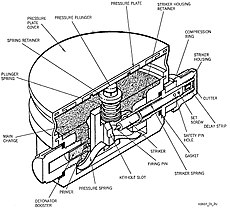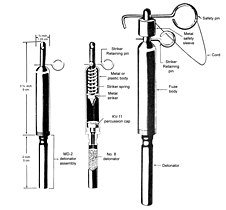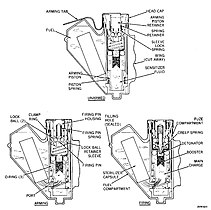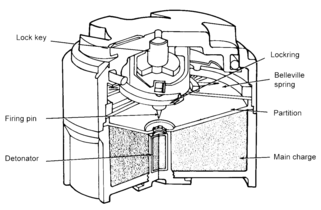
A firearm is any type of gun that uses an explosive charge and is designed to be readily carried and used by an individual. The term is legally defined further in different countries.

In firearm designs, the term single-shot refers to guns that can hold only a single round of ammunition inside and thus must be reloaded manually after every shot. Compared to multi-shot repeating firearms ("repeaters"), single-shot designs have no moving parts other than the trigger, hammer/firing pin or frizzen, and therefore do not need a sizable receiver behind the barrel to accommodate a moving action, making them far less complex and more robust than revolvers or magazine/belt-fed firearms, but also with much slower rates of fire.

The percussion cap or percussion primer, introduced in the early 1820s, is a type of single-use percussion ignition device for muzzle loader firearm locks enabling them to fire reliably in any weather condition. Its invention gave rise to the cap lock mechanism or percussion lock system which used percussion caps struck by the hammer to set off the gunpowder charge in rifles and cap and ball firearms. Any firearm using a caplock mechanism is a percussion gun. Any long gun with a cap-lock mechanism and rifled barrel is a percussion rifle. Cap and ball describes cap-lock firearms discharging a single bore-diameter spherical bullet with each shot.

A cartridge, also known as a round, is a type of pre-assembled firearm ammunition packaging a projectile, a propellant substance and an ignition device (primer) within a metallic, paper, or plastic case that is precisely made to fit within the barrel chamber of a breechloading gun, for convenient transportation and handling during shooting. Although in popular usage the term "bullet" is often used to refer to a complete cartridge, the correct usage only refers to the projectile.

Bolt-action is a type of manual firearm action that is operated by directly manipulating the bolt via a bolt handle, which is most commonly placed on the right-hand side of the firearm.

In firearms terminology, an action is the functional mechanism of a breech-loading firearm that handles the ammunition cartridges, or the method by which that mechanism works. Actions are technically not present on muzzleloaders, as all those are single-shot firearms with a closed off breech with the powder and projectile manually loaded from the muzzle. Instead, the muzzleloader ignition mechanism is referred to as the lock.
A repeating rifle is a single-barreled rifle capable of repeated discharges between each ammunition reload. This is typically achieved by having multiple cartridges stored in a magazine and then fed individually into the chamber by a reciprocating bolt, via either a manual or automatic action mechanism, while the act of chambering the round typically also recocks the hammer/striker for the following shot. In common usage, the term "repeating rifle" most often refers specifically to manual repeating rifles, as opposed to self-loading rifles, which use the recoil, gas, or blowback of the previous shot to cycle the action and load the next round, even though all self-loading firearms are technically a subcategory of repeating firearms.
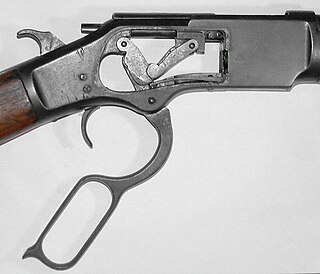
A lever action is a type of action for repeating firearms that uses a manually operated cocking handle located around the trigger guard area that pivots forward to move the bolt via internal linkages, which will feed and extract cartridges into and out of the chamber, and cock the firing pin mechanism. This contrasts to other type of repeating actions such as the bolt-action, pump-action, semi-automatic, fully automatic, and/or burst mode actions. A firearm using this operating mechanism is colloquially referred to as a levergun.

A breechblock is the part of the firearm action that closes the breech of a breech loading weapon before or at the moment of firing. It seals the breech and contains the pressure generated by the ignited propellant. Retracting the breechblock allows the chamber to be loaded with a cartridge.

The lock of a firearm is the mechanism used to initiate firing. It is a historical term, in that it generally refers to such mechanisms used in muzzle-loading and early breech-loading firearms. Side-lock refers to the type of construction, in which the individual components of the mechanism are mounted either side of a single plate. The assembly is then mounted to the stock on the side of the firearm. In modern firearm designs, the mechanism to initiate firing is generally constructed within the frame or receiver of the firearm and is referred to as the firing or trigger mechanism.
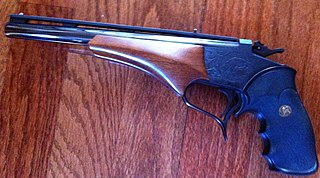
The Thompson/Center Contender is a break-action single-shot pistol or rifle that was introduced in 1967 by Thompson/Center Arms. It can be chambered in cartridges from .17 Bumble Bee to .45-70 Government.

Locked breech is the design of a breech-reloading firearm's action. This is important in understanding how a self-reloading firearm works. In the simplest terms, the locked breech is one way to slow down the opening of the breech of a self-reloading firearm when fired. The source of power for the movement is recoil.
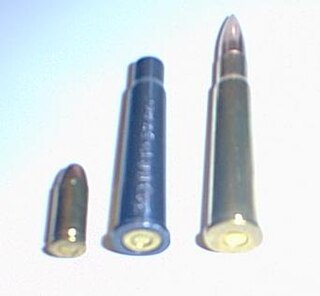
A caliber conversion sleeve or adapter sleeve is a device which can be used to non-permanently alter a firearm to allow it to fire a different cartridge than the one it was originally designed to fire. The different cartridge must be smaller in some dimensions than the original design cartridge, and since smaller cartridges are usually cheaper, the device allows less expensive fire practice.
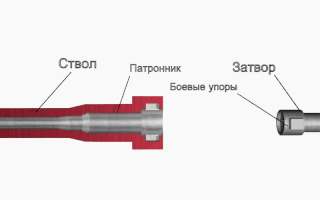
A slamfire is a discharge of a firearm occurring as a cartridge is being loaded into the chamber. Some firearms are designed to slamfire, but the term also describes a malfunction of self-loading firearms. Shooters accustomed to firearms requiring trigger activation for discharge may be unprepared for a slamfire discharge.

A hammerless firearm is a firearm that lacks an exposed hammer or hammer spur. Although it may not literally lack a hammer, it lacks a hammer that the user can pull directly. One of the disadvantages of an exposed hammer spur is the tendency to get caught on items such as clothing; covering the hammer by removing the spur reduces this tendency.

Break action is a type of firearm action in which the barrel(s) are hinged much like a door and rotate perpendicularly to the bore axis to expose the breech and allow loading and unloading of cartridges. A separate operation may be required for the cocking of a hammer to fire the new round. There are many types of break-action firearms; break actions are universal in double-barreled shotguns, double-barreled rifles, combination guns, and are commonly found in single shot pistols, rifles, shotguns, including flare guns, grenade launchers, air guns, and some older revolver designs. They are also known as hinge-action, break-open, break-barrel, break-top, or, on old revolvers, top-break actions.
The following are terms related to firearms and ammunition topics.

In firearms, a safety or safety catch is a mechanism used to help prevent the accidental discharge of a firearm, helping to ensure safer handling.
Recoil operation is an operating mechanism used to implement locked-breech autoloading firearms. Recoil operated firearms use the energy of recoil to cycle the action, as opposed to gas operation or blowback operation using the pressure of the propellant gas.
In firearms and artillery, the primer is the chemical and/or device responsible for initiating the propellant combustion that will propel the projectiles out of the gun barrel.
